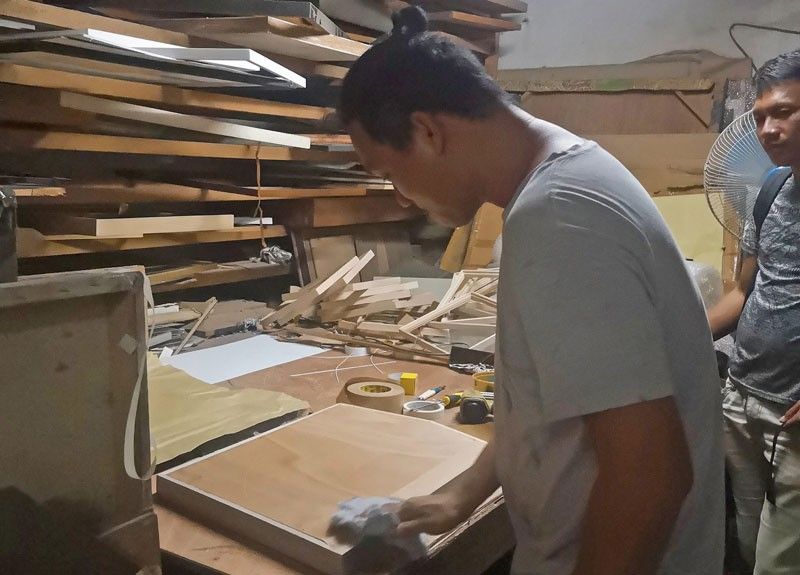Frame by frame

The frame is simultaneously ubiquitous and invisible in contemporary art. Not only is it important in the preservation and display of wall-bound works, it’s an extension of the art object itself. Framing is a key step in preparing a work for exhibition, which in turn helps the artist make a living.
Word of trusted framers circulates among art communities, and each artist has his or her own suki: Noe Supreda, whom many artists fondly call “Kuya Noe,” is one of them. He works at Jaga Wood, a framing shop along 15th Avenue in Cubao that has been around since 1983. Long before the Philippine art landscape was shaped into what it is today (or, rather, had been up to two months ago), with its flurry of auctions, art fairs and openings, Noe was already a professional framer.
He oversees a team of 15 framers who specialize in every step of the process, from molding and assembling wood to finishing touches. His is the final step of attaching the art to the frame. People attest to Noe’s knack for knowing the ideal frame for an artwork. It’s a sensibility that’s been cultivated since his youth, which was spent watching his father working on framing, too. Despite taking up I.T. (information technology), he found himself gravitating back to the craft in adulthood.

“’Di talaga basta-basta mag-frame,” he tells me over a phone call. To him, framing is a craft in itself that requires a certain level of skill and attention to detail to make sure that an artwork is presented with dignity.
Day-in, day-out, a wildly varied array of objects passes through the workshop. Here, future auction prize paintings await their frames along with family photos, graduation certificates, and memorabilia. A frame invokes a sense of specialness, inviting a viewer to direct his or her attention to what it contains. It bestows a special aura that distinguishes an object from what surrounds it, and enables the irreplaceable to last. Because of this, framing is a transaction in which trust is built between the customer and craftsman. Noe knows this well.
“Kasi ang artwork, lalo na kung papel lang iyon o nakarolyo lang yan, di kasi ‘yon naa-appreciate. Ilalagay mo lang sa gilid, ‘di siya nakikita. So kahit sabihin natin na ipakita mo ‘yon, parang yung collector kasi, mas gusto nila naka-frame; tsaka navi-visualize nila.” he says. Variables such as the choice of material, the degree of embellishment, matting, profile, mounting — these can make all the difference in the world in highlighting an art object’s best qualities. “Parang napapaganda niya yung painting.”
Noe’s frames have graced works from both emerging contemporary artists to esteemed masters such as BenCab and Sanso. “Kaya nakahiligan ko ang pag-fe-frame. Dahil nga sa mga artwork, gustong-gusto ko na makakakita ako,” Noe exclaims. “Lalo na ‘pag mga National Artist, parang sa akin, ‘O, na-frame ko ‘yon!’” Among his favorite long-time customers is Luis Lorenzana, who is also known for using distinctly ornate frames.
“Daming artists na nagiging kaibigan ko. Magsimula sa bata, hanggang may edad na,” he says. When I ask him who his favorite artists are, he fondly recalls a lot of names, from young and old alike. It’s no wonder he’s at ease with striking up conversations, even over a phone call. “Minsan kasi may kliyente na manonood lang, babantayan ka lang, kakausapin ka para di nga sila ma-bore habang ginagawa ang artwork nila.”

Operations for Noe tend to ramp up at the workshop around National Arts Month in February, leading up to Art Fair Philippines and Art in the Park. Of course, business suddenly halted when the Luzon-wide lockdown was implemented last March.
“Nagulat nga din kami. Biglaan din ang pangyayari. Marami pang humahabol kasi ‘di ba. Noong bago mag-lockdown, sadsad ang Art Fair,” he says. “May mga exhibit pa na sunod-sunod. Sa ngayon, na-tengga lahat.” With hardware supply chains cut off, the workshop is also short on materials such as wood and glass. In turn, some art sales were also left at a standstill.
“Nagkakausap kami ng mga artist ngayon. Sabi nila, minsan may nagvi-viewing pa rin kahit paano through social media,” he shares. “Kahit papaano naman daw, nakakabenta pa sila pero wala pang transaction. Sabi yung mga karamihan kasi ng mga painting ngayon kailangan ng framing, eh doon din sila nakakabenta pag naka-frame na.”
In the constellation of Philippine visual art, everyone is pretty much within six degrees of separation from a reliable art framer. Framing is the finishing touch: work that is essential to the market, to exhibition spaces, and collectors. Of course, it’s also Noe’s bread and butter, and something in which he takes great pride.
“Para sa akin, ‘yon kasi pinagbubuhay ko sa pamilya,” he says. “Bilang sa trabaho ko siya, iba yung saya mo pag nakakita ka ng artwork. Kahit anong medium ‘yun, basta nakikita ko. Minsan tinatanong nila ako, o, kilala mo ‘yon ah! Oo! Kilala ko ‘yan, nakagawa na ako n’yan eh. Dahil doon, napupuri ako.” For now, he’s looking forward to the day that he’ll be back in the workshop, supporting the community that turns to framers and craftsmen like him.



















